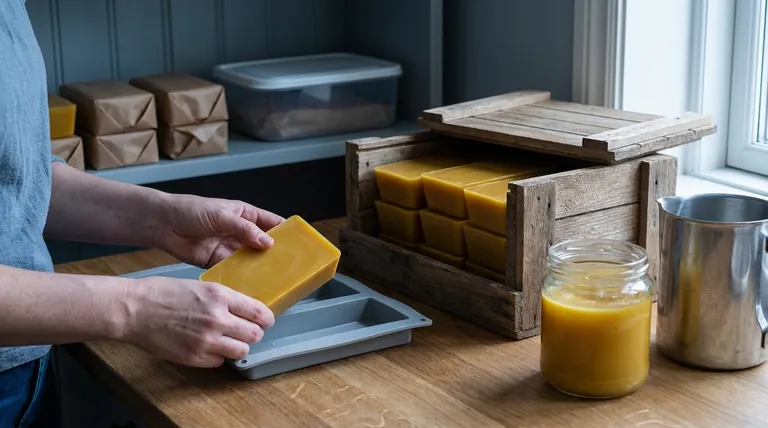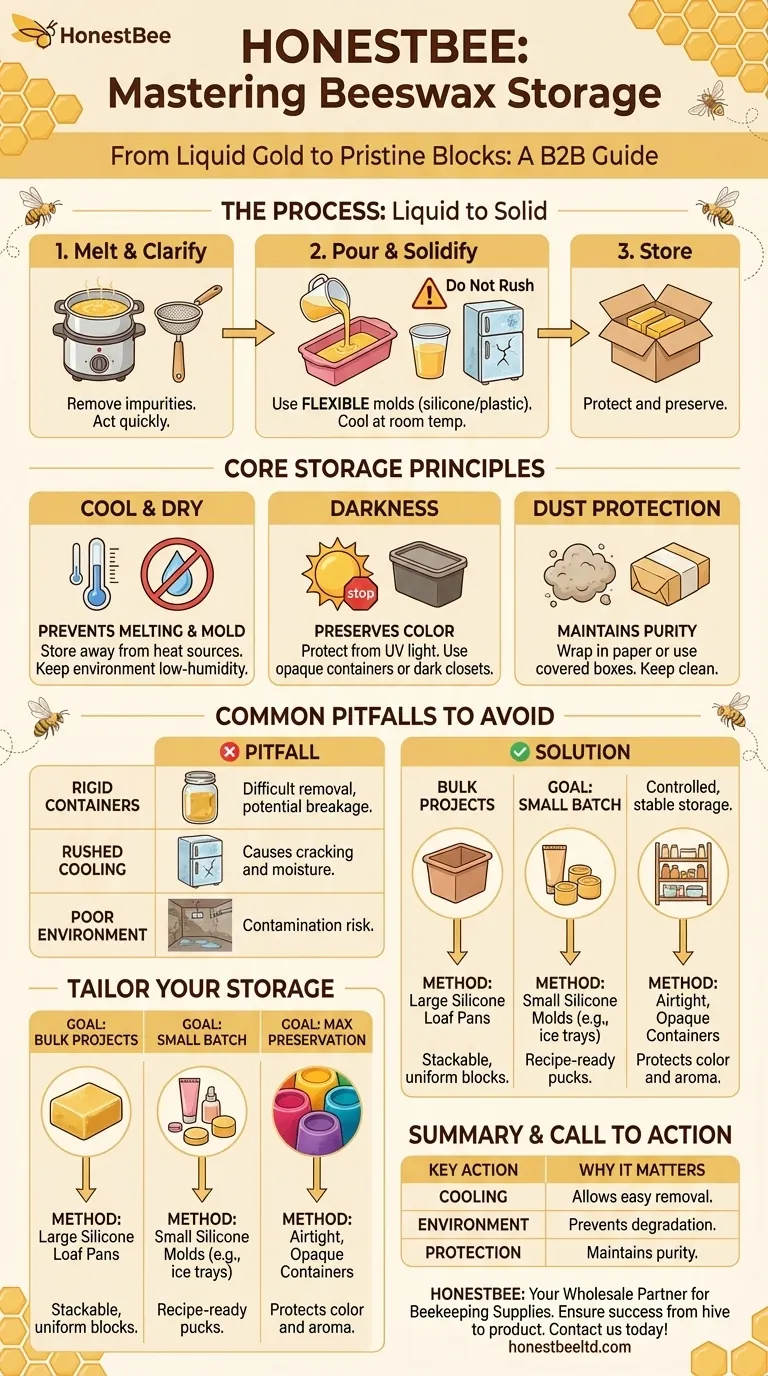After melting and clarifying, your beeswax should be poured into suitable molds, allowed to harden completely, and then stored in a cool, dry, and dark environment. This process ensures the wax remains clean, stable, and ready for future use without degrading in quality.
Storing beeswax properly is not just about preventing spoilage; it's about preserving its purity and creating convenient, pre-portioned blocks that streamline your future projects, whether you're making candles, cosmetics, or wood polish.

The Process: From Liquid Gold to Solid Block
Properly solidifying your rendered beeswax is the critical first step in successful storage. The choices you make here determine how easy the wax is to handle and use later.
Selecting the Right Molds
The ideal container for cooling beeswax is one that allows for easy removal. Rigid containers like glass or metal can make it very difficult to extract the solid block without re-melting or breaking the container.
Use flexible plastic or silicone molds. Baking pans, loaf pans, or even sturdy plastic cups work exceptionally well. These can be flexed to release the hardened wax block cleanly.
Pouring and Solidifying
Once fully melted and clarified, you must act with purpose. Beeswax begins to solidify quickly once it is removed from the heat source.
Pour the liquid wax immediately into your prepared molds. If you notice any final particulates, you can perform one last strain through a layer of cheesecloth or a fine metal sieve as you pour.
Allow the wax to cool and harden at room temperature, preferably overnight. Rushing this process by placing it in a refrigerator or freezer can cause the block to crack.
Core Principles of Long-Term Storage
Once your beeswax has hardened into solid blocks, the goal is to protect it from environmental factors that can cause it to degrade.
Why "Cool and Dry" is Essential
Heat is the most obvious enemy of wax. Store your beeswax blocks in a place that does not experience high temperatures, like a hot attic or garage, as they can soften or even melt.
Moisture is a more subtle threat. If any residual honey or organic debris remains after clarification, moisture can promote mold growth on the surface of the wax. A dry environment like a pantry or closet is ideal.
The Importance of Darkness
While beeswax is very stable, prolonged exposure to direct sunlight or other UV light sources can cause its rich yellow color to fade over time. Storing it in a dark location or an opaque container preserves its natural appearance.
Protecting from Dust and Debris
Your solidified beeswax blocks are pure and ready for use. To keep them that way, protect them from dust.
You can wrap the blocks in paper or store them in a simple cardboard box or covered container. This physical barrier is all that is needed to maintain their cleanliness.
Understanding the Trade-offs and Common Pitfalls
Avoiding a few common mistakes will ensure your stored beeswax remains a high-quality asset.
Pitfall: Using Rigid Containers for Cooling
Pouring hot wax into a glass jar may seem convenient, but it creates a significant problem. You will be unable to remove the solid block without either breaking the jar or melting the entire block of wax all over again.
Pitfall: Storing Before It's Fully Hardened
If you stack or wrap wax blocks that are still soft or warm in the center, they can deform easily. Worse, if they are still warm, wrapping them in plastic can trap condensation, introducing the moisture you are trying to avoid.
Pitfall: Neglecting Environmental Control
Storing unwrapped beeswax in a dusty workshop or a damp basement is the fastest way to contaminate it. The time you spent clarifying the wax will be wasted if its storage environment reintroduces dirt or moisture.
Making the Right Choice for Your Goal
Your storage strategy can be tailored to how you plan to use the beeswax.
- If your primary focus is bulk storage for various future projects: Pour the wax into larger, uniform blocks using silicone loaf pans. These are easy to stack and store, and you can cut or grate off what you need later.
- If your primary focus is making small-batch cosmetics or balms: Pour the liquid wax into small, pre-measured silicone molds (like an ice cube tray) to create 1-ounce or 2-ounce pucks for easy, recipe-ready use.
- If your primary focus is preserving maximum color and aroma: Ensure the blocks are stored in a dark, airtight container to protect them from both UV light and ambient dust.
By handling this final stage with care, you ensure your beautifully rendered beeswax remains a pure and valuable resource for any project you choose.
Summary Table:
| Step | Key Action | Why It Matters |
|---|---|---|
| Cooling | Pour into flexible silicone/plastic molds. | Allows for easy removal of the solid block. |
| Environment | Store in a cool, dry, and dark place. | Prevents melting, mold growth, and color fading. |
| Protection | Wrap blocks in paper or store in a covered container. | Shields wax from dust and debris, maintaining purity. |
Need reliable, high-quality supplies for your beekeeping and wax-rendering operations? HONESTBEE is your trusted wholesale partner, supplying commercial apiaries and equipment distributors with the durable tools needed for every step of the process—from hive to finished product. Ensure your beeswax and honey harvests are a success with our professional-grade equipment. Contact HONESTBEE today to discuss your wholesale needs!
Visual Guide

Related Products
- Electric Flatting and Embossing Machine with Tray for Beekeeping
- Electric Beeswax Flat Sheet Machine with Operating Tray for Wax Processing
- Manual Beeswax Flat Sheet Machine for Beeswax Processing
- Electric Beeswax Foundation Machine With Operating Tray and Wax Foundation Roller
- Professional Thermostatic Conical Honey Melter
People Also Ask
- What tools are used to add intricate details to beeswax sheets? Find the Right Embossing Method for Your Scale
- What qualities are important for someone starting in beekeeping? Build a Thriving Apiary with the Right Mindset
- What is the importance of soaping the rollers during milling? Prevent Wax Adhesion & Equipment Downtime
- What are the main components of a beeswax foundation sheet machine? A Guide to Efficient Production
- How does pressed honey compare to extracted or crush-and-strain? Unlock the Full Flavor of the Hive



















